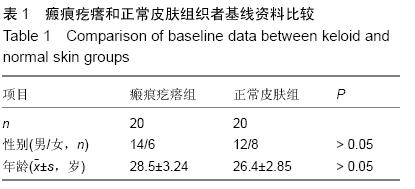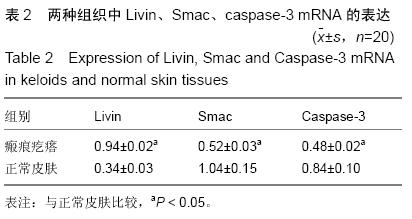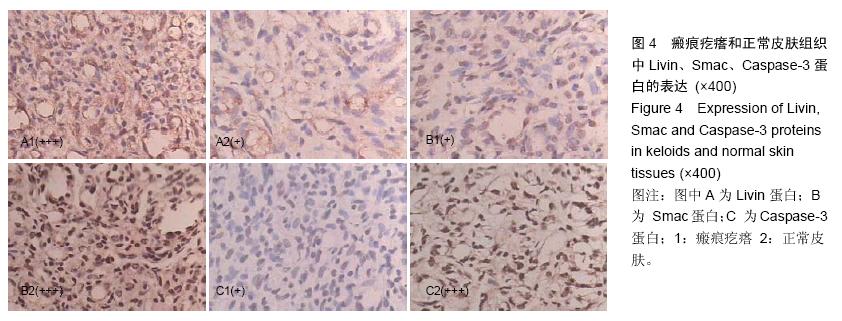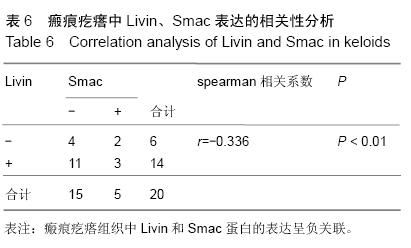| [1] 郭亮,徐凯,章鑫,等.PTEN,Akt,TGF-p1蛋白在瘢痕疙瘩中的表达[J].中国美容整形外科杂志,2013,24(8): 505-507.[2] Viera MH,Vivas AC,Berrnan B.Update on keloid management:linical and basic science advallces.Adv Wound Care(New Rochelle).2012;1(5):200-206.[3] Ledon JA,Savas J,Franca K,et al. Intralesional treatment for keloids and hypertrophic scars:a review.Dermatol Surg.2013;39(12):1745-1757.[4] Liu XD,Fan RF,Zhang Y,et al.Down-regulation of telomemse activity aIld activation of caspase-3 are re8ponsible for Tanshinone induced apoptosis in monocyte leukemia ceⅡs in vitro.Int J Mol Sci.2010; 11(6):2267-2280.[5] 刘守洲,林立强,王孝,等.Livin和Bcl-2在喉鳞状细胞癌的表达及相关性研究[J].济宁医学院学报,2011,34(2): 90-92.[6] 肖维,彭健,张阳德.mPEG-CS纳米粒介导livin shRNA基因纳米复合物的制备及转染效率[J].中国组织工程研究与临床康复,2011,15(16): 2920-2924.[7] 杨珊珊,马楠,罗晓华.凋亡抑制基因Livin在宫颈鳞癌组织中的表达及其与Bcl-2的关系[J].肿瘤基础与临床,2009, 22(2):116-118.[8] 李春霞 魏红军 郜玉玲,等.Livin和Smac 在鲍恩病及皮肤鳞状细胞癌中的表达. [J].中国麻风皮肤病杂志,2014, 30(2):70-73.[9] 曲才杰,史同新,毕健平,等. Livin和Smac在基底细胞癌的表达及其意义[J]. 中华皮肤科杂志,2013,46(10): 723-725.[10] GolsteinP.Controlling cell death.Science. 1997; 275 (5303):1081-1082.[11] 陈煜华,鲁开化,刁建升,等. 靶向沉默血管内皮生长因子对兔耳增生性瘢痕的影响[J]. 中国美容整形外科杂志, 2013,24(3):144-147.[12] 于冬梅,丁爽,尚勇,等.瘢痕疙瘩中人端粒酶逆转录酶和caspase-3基因的表达及意义[J]. 中国美容整形外科杂志, 2015,26(3):132-134.[13] Chhanabhai M, Krajewski S, Krajewska M, et al. Immunohistochemical Analysis of Interleukin-1b- Converting Enzyme/Ced-3 Family Protease, CPP32/Yama/Caspase-3,in Hodgkin’s Disease.Blood. 1997;90(6):2451-2455.[14] Krajewski S, Gascoyne RD, Zapata JM,et al. Immunolocalization of the ICE/Ced-3-amily Protease, CPP32(Caspase-3),in Non-Hodgkin’s Lymphomas, Chronic LymphocyticLeukemias,and Reactive Lymph Nodes.Blood.1997;89(10):3817-3825.[15] Andreas Hartmann, Stephane Hunot, Patrick P.Michel,et al.Caspase-3:A vulnerability factor and final effector in apoptoticdeath of dopaminergic neurons in Parkinson’s disease.Proc Natl Acad Sci.2000;97(6): 2875-2880.[16] Jonges LE, Nagelkerke JF, Ensink NG, et al.Caspase-3 Activity as a Prognostic Factor in Colorectal Carcinoma. Lab Invest. 2001;81(5):681-688. [17] Giannopoulou I, Nakopoulou L, Zervas A, et al. Immunohistoche- mical study of pro-apoptotic factors Bax,Fas andCPP32 in urinary bladder cance-r: prognostic implications.UrolRes. Urol Res. 2002;30(5): 342-345.[18] Du C,Fang M,Li Y,et al.Smac,amitochondrial protein that promotes cytochrome c-dependent caspase activation by eliminating IAP inhibition.Cell.2000; 102(1): 33.[19] Verhagen AM,Ekert PG,Pakusch M,et al.Identification of DIABLO,a mammalian protein that promotes apoptosis by binding to and antagonizing IAP proteins. Cell.2000;102(1):43.[20] 张霞,千新来,崔静,等.乳腺良恶性病变组织中Livin和Smac的表达[J].郑州大学学报:医学版,2009,44(4):735. |







